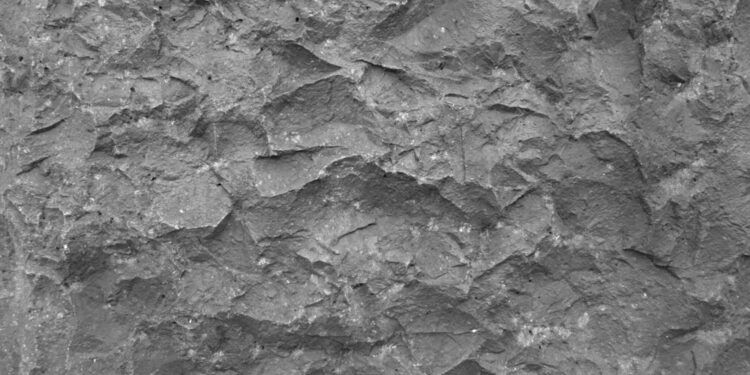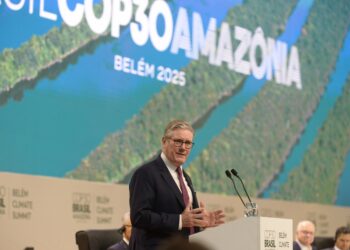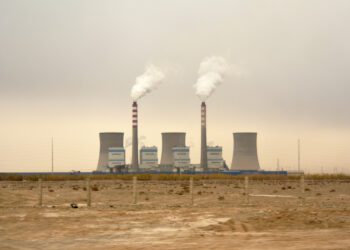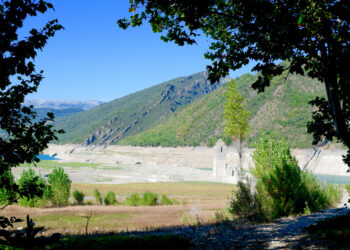Geologist Peter Kelemen has been working in the desert of Oman for more than 15 years to study natural chemical reactions within rare deep-earth rocks that pull carbon from the air and lock it into solid mineral form. His goal: harnessing and speeding up those reactions to remove carbon on an industrial scale. Based in large part on his research, Omani entrepreneurs recently formed 44.01, a company working to scale up and commercialize the processes. The company was just awarded a $1.2 million Earthshot Prize by Prince William, heir to the British throne, in a televised ceremony in Boston. Founded in 2021, the prize is aimed at funding five cutting-edge environmental ventures each year through 2030. We spoke with Kelemen about the science behind the project, its current state, and its prospects for the future.
Tell me about the rocks in Oman, and what makes them special.
The mountains of northern Oman and along the coast of the United Arab Emirates host a huge block of oceanic crust and upper mantle that was thrust onto the edge of the Arabian continent starting 96 million years ago. It is 350 kilometers long, up to 50 kilometers wide, and many kilometers thick. It is tilted, and exposes rocks that formed more than 20 kilometers below the sea floor. Surface exposures of the Earth’s mantle are quite rare, and this is the largest in the world. Spectacular canyons cut through it, so you can literally walk down into what used to be the Earth’s interior. Rocks like this react rapidly with CO2 in the atmosphere and surface water, and this forms solid carbonate minerals, for example limestone. The process is spontaneous. So we’ve been seeking to understand how it works, and then design methods that accelerate it in order to store significant amounts of CO2 on a human time scale. We are focusing on injecting CO2 dissolved in water underground. It might use a lot of water, and of course water is very valuable in the Middle East, so we look for areas near the coast, where there is an essentially infinite supply.
How did 44.01 start, and what is your involvement?
I and my colleague Jürg Matter, who was formerly at Columbia, were first approached by on Omani entrepreneur, Talal Hasan, in about 2017, when he was working for Oman’s sovereign wealth fund. Talal hoped to persuade the government to invest in CO2 storage in the mantle rocks. But then he ended up leaving the fund, and he and a childhood friend founded 44.01. Jürg now works with them about half time. I plan to remain in more of an advisory role.
Where would the carbon come from?
44.01 has obtained a solar-powered device that removes CO2 directly from air, from the Swiss company Climeworks. They’re operating it near Oman’s capital city, Muscat. For pilot studies, we could also use CO2 captured from smokestack sources, like the many gas-fired power plants, water desalination plants and other industrial operations in Oman and the UAE.
How far has the company come, and how would it make money?
We’ve obtained government permits and run some small pilot projects at a former scientific drilling site. We are now planning two much larger pilot projects, both expected to take place in 2023. Ideally we would achieve substantial results before the COP28 meeting in the UAE, in 2023. Eventually, we hope, some government or group of governments would pay them to lock up the carbon, at a rate of maybe $30 a ton. Globally, such costs end up being a few percent of GDP, comparable to the current costs of solid waste management.
What difficulties might the project face?
The main concern is that the rocks are not very porous.. That leads to two difficulties. One, it can be difficult to get fluids to circulate rapidly through the rocks, and two, the pore space might eventually clog up with newly formed carbonate minerals. However, we are inspired by the fact that in some places the rocks have naturally become fully carbonated. That is, every magnesium and calcium atom in them has combined with CO2 to create solid minerals. So we know this can happen, and we have ideas about how it works. We have done theoretical calculations, and conducted experiments at the laboratory scale. But in the end, only field scale experiments will allow us to refine methods to do this at a reasonable cost.
Are there other places with similar rocks?
Yes, but Oman and the UAE are the best. The next largest outcrops are in New Caledonia and Papua New Guinea. They would be great places to take CO2 from the air, but I think we need to demonstrate that this process works on the Arabian peninsula before trying to get things going on islands in the southwest Pacific. There are other, smaller areas that could work, including parts of California and Oregon. However, those spots are water-limited, and I expect local stakeholders would be concerned about that. Then there are small coastal outcrops in southeast Alaska that have a lot of potential and plenty of water, but they are so remote that I think we need to provide proof of concept before we can justify operations there.
Are you continuing research in Oman or elsewhere?
In addition to forming solid carbonate minerals, the reaction of surface waters with mantle rocks can form free hydrogen gas. It is widely viewed as a potential replacement for fossil fuels, specifically natural gas and oil, for transportation and home heating. And if derived at low cost from natural sources, it could also be used to generate electricity. We are continuing academic research on the rate of hydrogen formation, and studying ways that could be accelerated. In the United States and Canada, we are also investigating how some mining ores could not only lock up carbon, but help with the extraction of nickel and cobalt—essential ingredients that will be used extensively in electric vehicles and renewable energy generation in the next few decades.
Did you get to attend the awards ceremony?
No. The Earthshot organization wished to limit their carbon footprint, so rather than flying dozens of people to Boston from all over the world, they organized an award event in Oman for the 44.01 personnel there, and filmed that.
Courtesy Columbia Climate School. By Kevin Krajick. Article available here.












